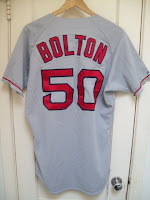On a steamy summer night in 1999, the pride of Belleville, N.J., stepped to bat at McCoy Stadium for the Pawtucket Red Sox. A brawny catcher named Creighton Gubanich, his six-foot-three-inch, 200-hundred-pound frame inspired fear and respect throughout old McCoy – that gem of a ballpark where South Bend Street meets Division Street.
In Section 13 (cheap blue seats, obviously), a bricklayer from East Providence named Vasco Paiva screamed obscenities in Portuguese. (He might have actually just been talking pleasantly with his children).
Across the street in that school parking lot where everyone parks illegally, children put down their crackpipes just long enough to try to hear the crack of the bat.
Atop the outfield fence, that Marlboro Man cowboy sign quivered at the thought of Gubanich hitting a home run right off his face.
On the streets of Pawtucket, the Buzzy’s Peanuts cart guy paused and stopped thinking about whether his child support was late – it was Craighton’s time.
And in the red infield seats, I sat with my dad, brother and some kid from Fairhaven wondering what Creighton Gubanich would do. As it turned out, he grounded to short and dogged it up the first base line. I was bummed – this guy was a hero to me, and here he was ambling up the first base line like a Del’s Lemonade guy on a cold day.
“Leg it out, Creigh!” I yelled at a reasonable volume.
He was out, by probably 15 feet.
“You’re a homo,” my brother said.
“Why?” I replied.
“Because you just yelled ‘Leg it out McCray’ or some gay shit at this minor league game,” he said.
“Yeah Pat that was pretty gay,” said the kid from Fairhaven, who I think now has a Facebook page where he advertises that he’ll come over and clean your poolcage for a fee.
I tried to explain that I think Creighton Gubanich was a good player and could make a decent living in the majors if he hustled some more, but no one wanted to hear it.
And you know what? I still think Creighton Gubanich could have been a good player. He spent eight years in the minor leagues with different organizations before the Red Sox finally gave him a legitimate shot at a big league role, and he made the most of it. In Gubanich’s third major league appearance, the Sox started him at catcher against the Oakland A’s – the same franchise that drafted Gubanich in the sixth round of the 1990 amateur draft. Surely young Gubanich, then a boy of 18, had dreams of playing for the A’s in Skidz and shaving a picture of the A’s elephant into his flattop (it was 1990). But that never happened, and this was his chance to exact revenge.
And he did. In the top of the first inning he crushed a grand slam off of Jimmy Haynes. (It is worth noting that Brian Daubach – from Belleville, Il. – scored on the homer. This marked probably the only time in major league history where two guys whose hometowns have the same name, but are not in the same state, scored on a grand slam.) Donnie Sadler ran for Gubanich later in the game, and he was replaced at catcher by someone named Varitek (speaking of flattops). The Sox would lose the game in extra innings when Tim Harikkala walked John Jaha to force in Tim Raines (speaking of crackpipes) with the winning run.
That game wasn’t the end for Gubanich, who would hit a respectable .277 in 18 games for the ’99 Sox. But he never played in the majors again. His career ended in 2003 with the Double A Chattanooga Lookouts, who have the best hats of any minor league team.
When you think about it, Gubanich’s career is very similar to that of Crash Davis (Costner’s character in Bull Durhan, not the Western Mass. band). Both hit a ton of home runs in the minors (Gubanich hit 155). Both had very brief tenures in the major leagues that lead to great stories (Davis has his stories about being “in the show,” while Gubanich probably bores his family at Thanksgiving every year with the story of his one major league home run). Both made out with Susan Sarandon (I’m giving Creighton the benefit of the doubt here). The major differences are that Crash Davis is made up and that Davis had Nuke LaLoosh (portrayed by Tim Robbins, was way too old to play a young, up-and-coming pitcher in 1988). Gubanich never found his Nuke LaLoosh. Perhaps it could have been Bo Donaldson, who played with Gubanich on the 2002 Columbus Clippers. But it wasn’t.
I’ll never forget Creighton Gubanich, even though he has faded into baseball obscurity. He was the fourth player in MLB history to hit a grand slam in his first hit. Daniel Nava, who turned that trick this year, could be the next folkloric PawSox hero. Only time will tell.
Until then, leg it out, Creigh.





































































